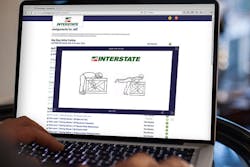A good article by Boaz Amidor cloud-based training firm WalkMe identifies many of the reasons many workers – managers as well as front-line employees – dread days when they have to sit through safety meetings, or wellness programs, and the like.
Often it’s because they are boring and spin out gobs of information that’s hard to process, let alone retain.
Indeed, Amidor noted in his story that one study indicated that people only retain about 30% of what they’ve learned after a one-time “information dump.”
And when such “dumps” involve the meticulous nature of, say, trucking safety regulations, the information-retention issue only worsens.
“If your drivers are actively avoiding meetings, if few of your drivers are completing the online training assignments you give them, if training doesn’t seem to translate into improved performance, maybe it’s time to rethink the training you're providing,” noted Jane Jazrawy, co-founder and chief executive of CarriersEdge, a Canada-based online trucking-industry training provider.
“When drivers are not engaged, your training program might be wasting time and money. When your safety messages aren't getting through, you're also potentially hurting your company's performance,” she said.
Certainly there are too many examples of training meetings and seminars highlighted by droning speakers reading their PowerPoint slides to an audience of bored and inattentive employees who won’t remember a single thing five minutes later, other than how dull the meeting was, Jazrawy pointed out.
“But training is too important to simply go through the motions,” she stressed. “Whether it’s new drivers or veterans needing refreshers and updates, and whether the topic is safe-driving practices or changes in hours-of-service rule, employees need good training to do their jobs safely and effectively.”
To that end, Jazrawy offers four training tips for trucking companies.
Figure out what it is you want people to learn: The point of training is not to fill hours or to check one more item off a to-do list. It’s to transfer information to employees. So Jazrawy believes “starting at the end” by establishing the ultimate learning objectives of any training program.
“What should your learners know after they've completed this training? How will you know if you’ve accomplished what you wanted? Did everyone get trained? Is more training required?” she said.
“It doesn’t matter whether it's a classroom training session or an online module; learning objectives don't care how you deliver training, just what the outcome is going to be,” Jazrawy emphasized. “A classroom presentation on fatigue management, for example, might concentrate on such outcomes as drivers able to recognize the signs of fatigue as a signal to stop driving, or knowing about sleep-apnea testing programs they can access. Once you know the outcomes, you can write the objectives.”
The key to writing objectives to avoid words like understand, know and recognize and instead rely on “action words” such as demonstrate, list, explain, describe and compare.
In the case of a driver fatigue-management course, for example, that would mean learning objectives such as “list signs of fatigue,” “describe how fatigue impairs judgment” and “explain ways of managing fatigue.”
Attaching numbers, such as “list five common signs of fatigue,” or specific actions such as “define fatigue as it relates to commercial driving,” can help further define and list objectives, Jazrawy said.
The general rule is four or five objectives for about two hours of classroom content or 30 minutes of online training, she added.
Don’t over-organize: With learning objectives in hand, the trainer can then put together the material to reach the desired outcomes. However, in far too many cases, Jazrawy said that often translates into “endless decks” of PowerPoint slides, each with lists of bullet points.
“Bullet points aren't necessarily bad, but endless bullet points that don't contribute to the overall message that a presentation is trying to deliver are going to be boring for your audience,” she stressed.
Jazrawy recommends working from the general to the specific, giving the big-picture overview and then working toward the details – with a focus on translation and simplification.
“There is a tendency in the industry to present the regulation exactly as it’s written,” she explained. “This is a terrible idea because often those regulations are extremely difficult to understand. They are written by lawyers, not by educators, and they’re written so that they can be enforced and defended, not as teaching materials. Your job as a trainer is to translate and organize those regulations into chunks of information that people can understand and apply to their daily lives.”Training material should also build from basic concepts to the more complex, Jazrawy added.
“When you were in school, you didn't learn division first,” she emphaszied. “You learned addition, which is the simplest mathematical concept, and worked your way up from there to division, building confidence as you went along. The same principle applies to designing educational material for adults. When they feel more confident, they are more likely to apply a new concept or change their routines.”
Use of illustrations helps: No one wants to be bored by a droning lecturer, or having to read big blocks of text on a screen. Flow charts, timelines, images – such as photos, drawings and diagrams – plus videos can all be more effective in explaining how to apply the material being presented in the daily work routine.
“Any time I can, I use an image to demonstrate what a learner's success looks like,” Jazrawy said. “I try to have as many visual examples as possible. Think about whether your PowerPoint slide full of bullets could be better represented with a picture.”
Yet not every visual tool works for every type of material, she stressed.
“Videos should not be your entire training strategy, as they are not interactive, and they may not be the best way to explain every concept,” Jazrawy pointed out. “They are fabulous for demonstration purposes, such as conducting parts of an inspection or showing an example of dangerous driving. Regulations may be better explained with different techniques.”
Learning the lesson: Remember that list of learning objectives? They come in handy in putting together quizzes during the presentation and final-test questions, since the point of such testing is to determine if trainees understood, remembered and can apply the material.
“Learners aren’t the only ones who benefit from test questions. They can give a trainer a lot of information, too,” Jazrawy noted. “Did the training achieve its objectives? Does the material need to be tweaked, or overhauled? Are the questions clear? When learners don't understand what a question means or think that it's vague or tricky, that's the time to look at the question again and double-check the objective you are trying to achieve.”
Two final pieces of advice: Know and rehearse your presentation, so you’re not fumbling through it. And give some thought to including more “interactivity” in your training program – breaking up the presentations with quizzes or competitions so your audience becomes a group of active learners instead of passive attendees.
Good advice from someone who’s been providing training for a while now in the trucking industry.





